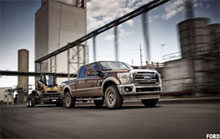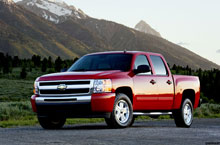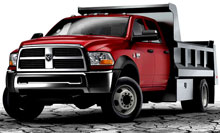After a great ride, the days of big pickup trucks driving sales and profits for U.S. car companies is over for good, a victim of rising fuel costs, a troubled economy and changing consumer tastes.
About half of the pickup market -- the buyer who didn't need a pickup for his work -- evaporated over the past decade. That same buyer isn't likely to return as he has in the past, industry experts say.
The big pickup, an American icon, has been down-and-out many times before but has always managed to stage a comeback whenever times were good. That cheered automakers since their outsized profit margins padded earnings.
"But we do think it's different this time," said Bill Visnic, an auto-industry analyst for auto research and sales adviser Edmunds.com, discussing pickups' latest sales cycle.
That's because of the volatile economy's erosion of consumer confidence coupled with the growing acceptance that gas is never going to be "cheap" again, he said. "Even the car companies are telegraphing that now" in their product mix.
At their peak of popularity in the late 1990s and early 2000s, pickup-truck sales made up almost 20% of the Big 3 Detroit automakers' annual sales, said Sean McAlinden, chief economist and vice president of research at auto industry think tank Center for Automotive Research in Ann Arbor, Mich.
In fact, Ford's F-series pickups have been the nation's top seller of all makes and models many times over during the past 30 years, some years selling over 800,000 trucks. To put that in perspective, Subaru sold 264,000 vehicles for all of last year.
 Courtesy of Ford |
McAlinden said he expects pickups' market share will likely remain at around 10% of total vehicle sales in the future, as tradesmen, businesses, farmers and ranchers, and the hard-core pickup lover who needs a vehicle to feed his ego or tow his adult toys around (boat, horse or snowmobile trailer), will remain loyal to them.
Jesse Toprak, an auto industry analyst for car-shopping website TrueCar.com, said, "Clearly, higher gas prices are an issue and the uncertainty over the economy" are reasons for the change in sales trends. Still, the sales decrease of trucks and SUVs stems from consumers' newfound fiscal conservatism.
"We see changed buyer behavior" in that the impulse buyer is gone, replaced by one seeking value, he said.
The excitement, or what car dealers used to call "the sizzle," of new-car buying has disappeared, especially for gas-guzzlers, he added.
Pickup trucks made up about 12% of industry sales in 2010 and have hovered around that share this year, although Ford (NYSE: F - News) and General Motors (NYSE: GM -News) both saw sales tumble 10% in May on the spike in fuel prices. Chrysler's Dodge Ram sales were up 38% in May, but that was from a very weak base last year when the company was operating in bankruptcy.
Tom Henderson, a GM spokesman, said "we think the underlying demand fundamentals still remain for the business-use buyers," and the industry forecast is for pickup sales to make up about 11% of total vehicle sales in the second half of this year, due in great part to pent-up demand from the business buyer.
As for consumers' shift away from big pickups, Henderson said GM is seeing the "personal use" buyer now opting for mid-sized "crossover" vehicles such as the Chevy Traverse and Equinox or the Buick Enclave, which have big cargo and passenger capacities, but are smaller and more fuel-efficient. They get about 24 miles per gallon, about 50% more than that of pickups.
Analysts don't expect total vehicle sales to be down this year at the Big 3. In fact, it will be a decent year if the economic recovery holds and gas prices moderate.
But pickups' market share isn't expected to rebound as in previous economic cycles, and that leaves a hole in companies' earnings, given pickups' fat profit margins.
 Courtesy of Chevrolet |
Visnic said pickups and SUVs had up to 30% profit margins, compared with 6% to 7% for a company's total product line. "That (loss) is not easy to make up."
For example, the profit margin on a Cadillac Escalade SUV or an "optioned-up" Ford F-350 could run $10,000 to $12,000, he said.
The closely matched 2011 Ford F-250, Dodge Ram 2500 and Chevrolet Silverado have manufacturers' suggested retail price ranges of $28,415 for the Chevy on the low end to $31,875 for the Ford on the high side.
A culprit for the sales decline is gas prices. The prospect of $4 per gallon fuel is seen as a sort of psychological tipping point in car buyers' minds when it comes to deciding on a full-size pickup or a mid-sized or small car, at least for use as a commuting vehicle or grocery-getter.
Full-sized pickups offered by Ford, GM's Chevy and Chrysler's Dodge Ram average about 14.3 miles per gallon, versus about 28 mpg from the Toyota Camry (NYSE: TM - News), a family sedan.
Assuming a consumer uses a tank of gas a week, at $4 a gallon, it would cost $104 to fill up a Ford F-150 pickup and $74 for the Camry, and that $30-a-week difference in a household budget now is a big gap for many families.
Toprak says Ford and GM executives have said, and it likely applies to Chrysler, that sales outside the U.S. is where their future growth lies and that the domestic market will continue to shift to smaller, more fuel-efficient vehicles. That will push companies to offer a more balanced product portfolio.
 Courtesy of Dodge |
Ford, for example, has made big steps to improve fuel efficiency, as it offers a modified V-6 for its pickups and new high-tech powertrains, both of which have boosted mileage while keeping the performance of many of its larger vehicles.
"The good news is that all of these companies are recognizing that they need to change," said Toprak, and they are putting management teams in place that can respond to meet consumer demand.
Indicative of the turmoil in the once-staid industry, on Tuesday, Chrysler shuffled its executive ranks, replacing its U.S. sales chief and the head of the Dodge brand, even though its sales are up 19.5% this year through May.
Ford is alone among the three big automakers that avoided bankruptcy reorganization in 2009, and it didn't get a government bailout, as did the others.
GM, after a post-bankruptcy initial public offering, is minority-owned by the U.S. government, with stakes held by the Canadian government, the United Auto Workers union and former GM creditors.
Chrysler is now majority-owned by Fiat after the Italian company repaid the U.S. government last month. LINK


